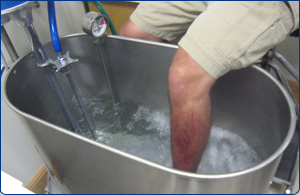 21st Sep 2015
21st Sep 2015
Treating Osteoarthritis with Physical Therapy
Arthritis is one of those conditions a lot of people expect to develop as they age. Osteoarthritis (OA) is a leading cause of musculoskeletal pain and disability. According to a study, an estimated 27 million Americans were living with OA in 2008. Osteoarthritis of the knee (knee OA) is a progressive disease causing inflammation and degeneration of the knee joint that worsens over time. The entire joint, including bone, cartilage, ligament, and muscle is affected with its progression influenced by age, body mass index (BMI), bone structure, genetics, strength, and activity level. Knee OA also may develop as a secondary condition following a traumatic knee injury. Depending on the stage of the disease and whether there are associated injuries or conditions, knee OA can be managed with physical therapy.

Physical Therapy Treatments for Osteoarthritis of the Knee
- Strengthening Exercises: Individuals with OA who adhere to strengthening programs have shown to have less pain and an improved overall quality of life. There are several factors that influence the health of a joint: the quality of the cartilage that lines the bones, the tissue within and around the joints, and the associated muscles. Due to the wear and tear on cartilage associated with knee OA, maintaining strength in the muscles near the joint is crucial to preserve joint health.
- Manual Therapy: Gently moving and mobilizing muscles and joints will improve their motion, flexibility, and strength. In patients with knee OA, the addition of manual therapy techniques to exercise has been shown to decrease pain and increase function.
- Electrical Stimulation: In a 2008 study published in The Journal of Clinical Rheumatology, researchers found that a four-week program of electrical stimulation was just as effective as a four-week exercise program in relieving pain and stiffness and improving physical function.
- Whirlpool Therapy: Whirlpool therapy has 3 main healing ingredients;
 heat, buoyancy, and massage. A study published in 2013 in The Journal of Physical Therapy Science showed that leg immersion in a warm-water whirlpool for patients with OA helped decrease pain and stiffness by 26-37%.
heat, buoyancy, and massage. A study published in 2013 in The Journal of Physical Therapy Science showed that leg immersion in a warm-water whirlpool for patients with OA helped decrease pain and stiffness by 26-37%. - Ultrasound Therapy: Ultrasound therapy has been shown to decrease pain, increase function and enhance cartilage repair. The sound waves of ultrasound are converted into heat within the deep tissues, which opens the blood vessels and allows oxygen to be delivered to the injured tissue of the knee.
There are some truly alarming statistics associated with Osteoarthritis. About 80% of patients with OA have some degree of movement limitation, while 25% cannot perform major activities of daily living and 11% of adults with knee OA need help with personal care. About 40% of adults with knee OA reported their health "poor" or "fair."
As the number of persons older than 65 years grows, the percentage of the population affected by Osteoarthritis will also grow. Osteoarthritis is a chronic condition that causes pain and decreases function which means the prevalence of this diagnosis and the need for physical therapy care will increase. Reduction of pain and improvement in function are the primary concern of those affected by Osteoarthritis and physical therapy with its wide-ranging tools is an important, non-invasive treatment option for patients, which can vastly upgrade their quality of life.





